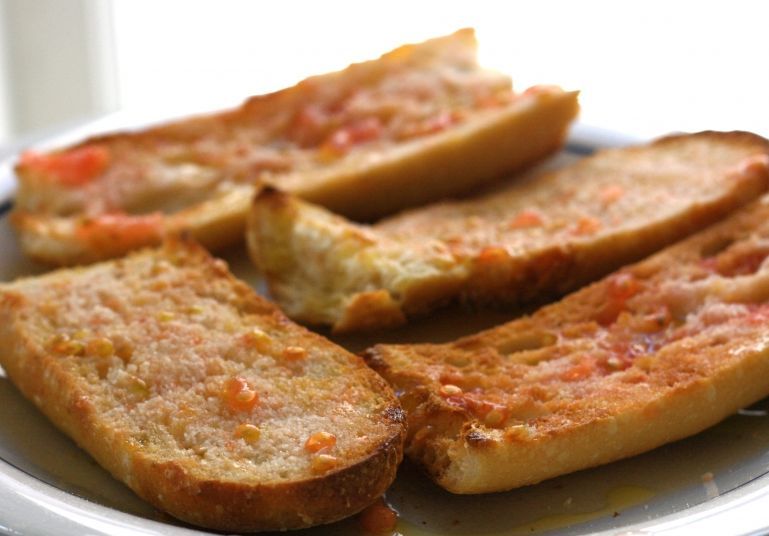16 Essential Catalan Dishes to Try
When it comes to food, Barcelona isn’t so much a Spanish city as a Catalan one.
An ancient, triangular-shaped region with 7.5 million inhabitants, the autonomous region of Catalunya has had its own language, history, culture, and traditions for close to a thousand years. While today, language might be the thing that most defines Catalan identity, its distinctive food follows closely behind. And the capital of Catalunya itself is also the undisputed capital of la cuina catalana — Barcelona.
From the 12th century, the principality of Catalunya had been in a union with the medieval kingdom of Aragon, and together they controlled a giant swath of the western Mediterranean, including what’s now southern Italy, Sicily, Sardinia, Corsica, Malta, the Balearic Islands, and parts of Greece. Even then, la cuina catalana — rooted in elements of its Greek, Roman, and Arab past — was highly regarded, with collections of its recipes printed throughout the Middle Ages (the Llibre de Sent Soví, published in 1324, is among the oldest surviving manuscripts in Europe). This cooking was representative of a rich, independent culture that included its own constitution, laws, and political structure, and Catalunya retained these even after the 15th-century marriage of Ferdinand and Isabella joined Aragon and Castile and laid the foundations for a modern, unified Spain. It wasn’t until the fall of Barcelona in 1714, at the end of the War of the Spanish Succession, that Catalunya lost its long-held autonomy. It would take (with a brief exception around the Spanish Civil War) more than 250 years to get it back.
But over these centuries, the region continued to foster its distinct identity. And its cuisine continued to absorb influences, especially with the arrival of products from the Americas, in dishes from European chefs working in Barcelona during the 19th century, and from the immigrants from other parts of Spain drawn to Catalunya’s economic prosperity in the 1950s and 1960s as the country grew more industrialized.
During Francisco Franco’s dictatorship (1939-1975), Catalans suffered particularly stringent cultural repression, including the prohibition of their language in public spaces.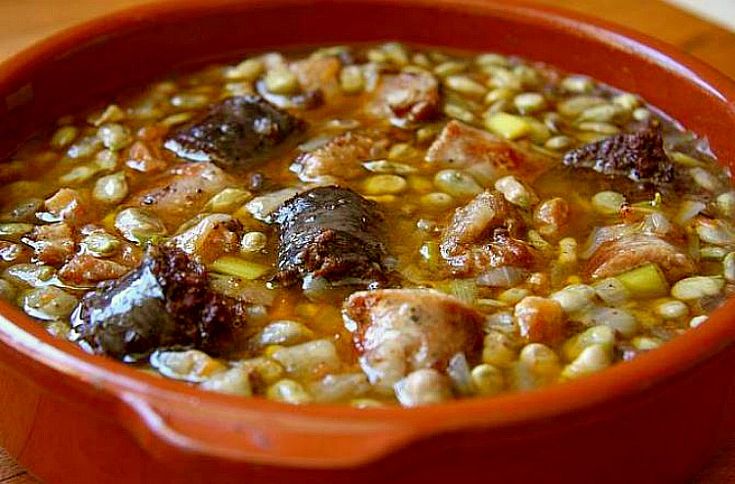
El Pont del Bisbe in the Gothic Quarter.Sunseekers along the beach in Barcelona.
“A country’s cuisine is its landscape in a pot,” goes a dictum attributed to Catalunya’s foremost food writer, Josep Pla. This cuisine is much more than a coastal one. Bordered to the north by the Pyrenees Mountains and France, to the east by 360 miles of Mediterranean coast, and with an interior of farmland and agricultural plains, the region’s products find their way into Barcelona’s markets, and ultimately, its kitchens.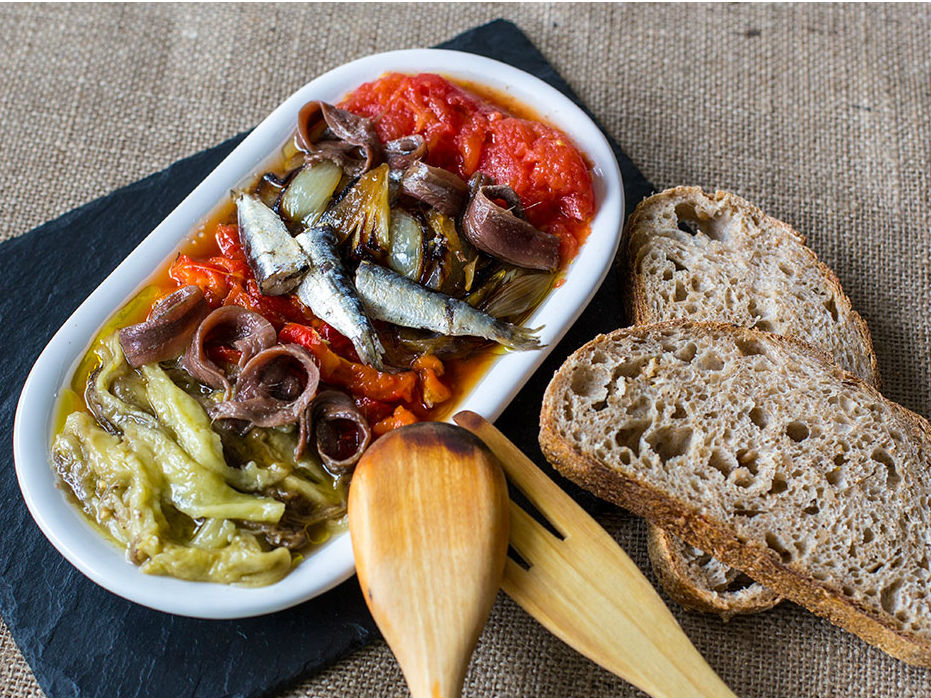
There are other defining signatures of Catalan cooking, like sofregit — a sweet pulp of onions and tomatoes patiently cooked down in olive oil. It’s not a sauce but the flavorful foundation on which countless dishes are built. Then there’s picada, a paste pounded in a mortar from garlic, parsley, and almonds or hazelnuts, plus maybe saffron or even chocolate (in its ancient guise as a spice). It’s stirred in toward the end of cooking to give everything from pots of lentils to braised meats more body, depth of flavor, and earthiness.
Perhaps all this makes Catalan cooking sound baroque. But as a rule, it isn’t. The focus remains on les matèries primes, high-quality ingredients that are cooked in ways that draw out and heighten their inherent flavors, not hide them.
Here, the seasons’ offerings are often celebrated for themselves: a cargolada for cargols (snails), a calçotada when calçots (local spring onions) ripen in late winter, a sardinada for sardines in summer. People here particularly like doing things in groups, and the Catalan table is often a crowded one — especially when the celebration is food itself.
After Franco’s death in 1975, freshly democratic Spain wrote a new constitution, and Catalunya was granted autonomy in many matters of regional self-government, including the restoration of their parliament and control over language and education. In 1979, with Catalunya’s culture beginning to visibly reemerge (including the return of Catalan as the language of the school system), the eminent journalist Néstor Luján warned that its cooking still faced two enemies: “la prisa” (being in a hurry) and tourism.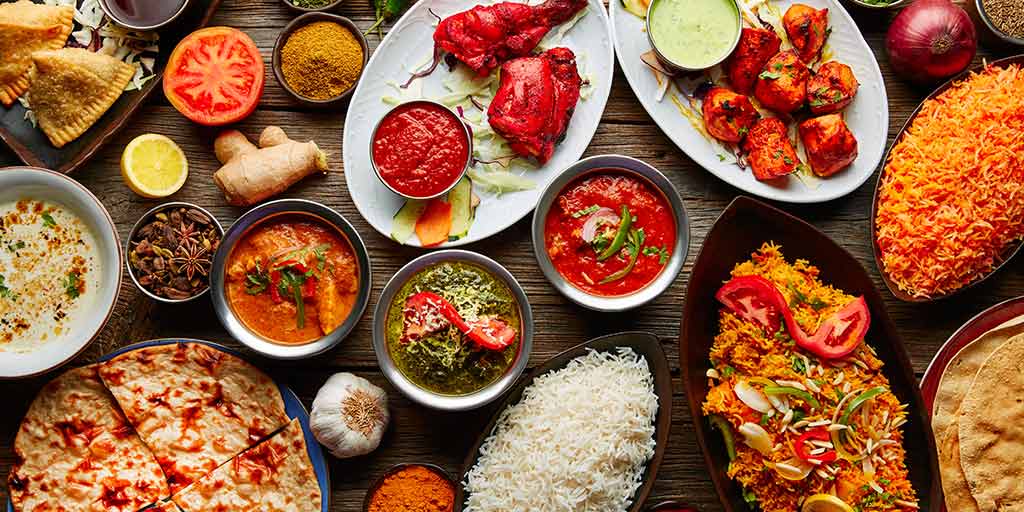
It isn’t the lack of interest from tourists that threatens it today in Barcelona, but rather, the sheer popularity of the city. It is easy to miss many of Catalunya’s potent culinary traditions in the sea of globalization and often poorly prepared tourist grub being served to visitors.
The 16 dishes that follow are classics of the Catalan kitchen, and you can find them all in Barcelona, the region’s capital and culinary crossroads. So skip that pre-prepared paella and giant mug of sangria on Las Ramblas, or even a bowl of grains in that third-wave coffee shop, and seek out these dishes instead.
Pa amb tomàquet at El Quim.
Pa amb tomàquet
(country bread rubbed with tomato and olive oil)
Nothing is more emblematic of the Catalan table than pa amb tomàquet, wide slices of (usually) toasted country bread rubbed with tomato, generously drizzled with olive oil, and sprinkled with sea salt.
Escalivada
(roasted red peppers, eggplant, and onions)
The name of the dish derives from the Catalan word meaning “to cook on hot embers,” which gives the roasted red peppers, eggplant, and onions their characteristic smoky flavors. The vegetables are roasted whole, peeled, torn into long strips, drenched in olive oil, and served cold.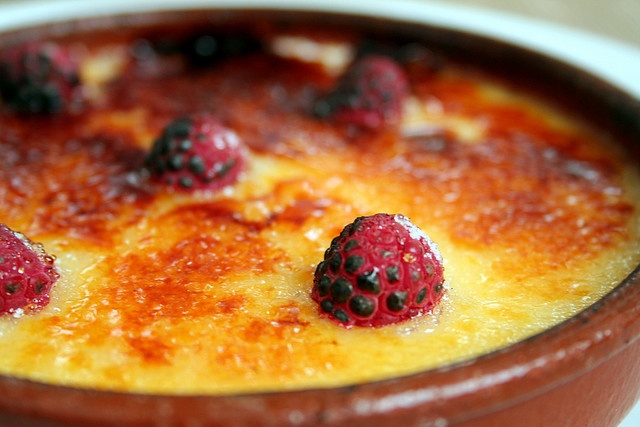
Esqueixada de bacallà at Can Cortada.
Esqueixada de bacallà
(shredded salt cod and tomato salad)
Ever since the Basques began bringing dried and salted cod to Spain back in the Middle Ages, the country’s cooks have been developing a seemingly inexhaustible number of ways to prepare it. The Catalans developed their own range of unique bacallà dishes, including the deeply popular esqueixada. The name is from the Catalan verb esqueixar (to shred), referring to the small, hand-torn pieces of cod in this magnificent salad with tomatoes, black olives, and olive oil.
Escudella i carn d’olla
(two-course soup)
This two-course soup was a daily staple for centuries in Catalunya, and remains so beloved that a full version is served as part of a traditional Catalan Christmas meal. Essentially, bones and pieces of meat (beef, pork, poultry), a large, oblong meatball called a pilota, chickpeas, and herbs and vegetables get boiled for a flavorful broth.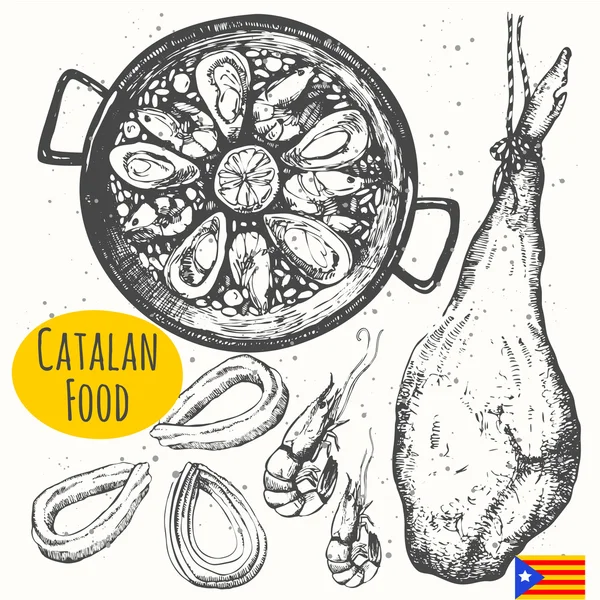
Espinacs amb panses i pinyons
(spinach with raisins and pine nuts)
Mixing sweet and savory is a hallmark of Catalan cuisine, and nowhere are these combined as simply — or deliciously — as in spinach with plump raisins and toasted pine nuts. So associated with the region is this vibrant dish that elsewhere in Spain it is known as espinacas a la catalana.
Peeling the calçots amb romesco at Can Cortada.
Calçots amb romesco
(calçots with romesco sauce)
Calçots are long, thick green onions that ripen in late winter. Grilled over embers, wrapped in newspaper, and brought to the table in concave terra-cotta roof tiles, they’re usually eaten outdoors and in groups.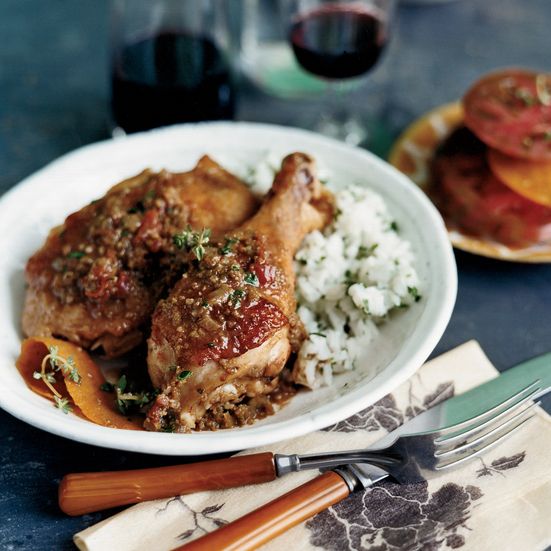
Arròs caldós amb llamàntol
(soupy rice with lobster)
“Soupy” rice with lobster manages to be a perfect blend of extravagance and comfort. It incorporates many of the finest elements of local cooking, it begins with a caramelized onion and tomato sofregit base and ends by stirring in a pounded picada of herbs, garlic, almonds, and dried red peppers to thicken the dish and give it a lush, nutty background.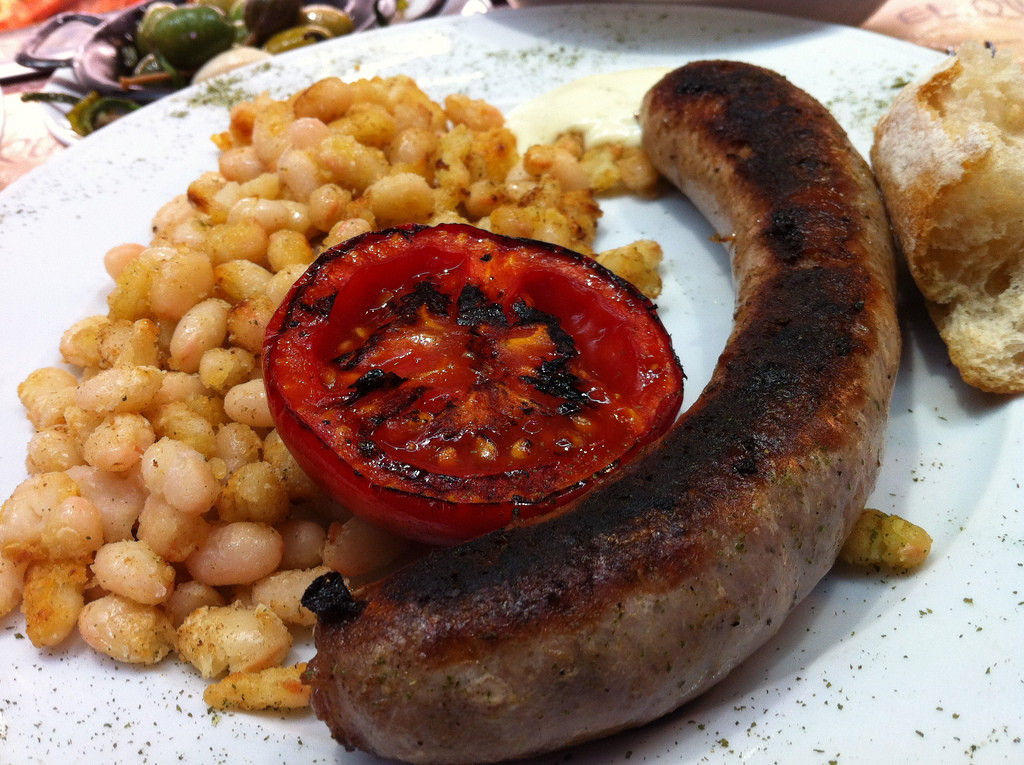
Arròs negre amb allioli at Can Cortada.
Arròs negre amb allioli
(black rice with allioli)
Fishermen eke out every last bit of worth from their catch. That means nothing gets wasted, not even the ink from a cuttlefish. The intense, jet-black distillation of the sea transforms this moist seafood rice dish from the Costa Brava north of Barcelona into something wholly spectacular. The key is the allioli served on the side, traditionally (and laboriously) made by pounding garlic with salt in a ceramic mortar and then adding olive oil drop by drop while stirring with the pestle until it forms a thick emulsion. It perfectly balances the natural sweetness of the ink.
Canelons de carn
(cannelloni stuffed with meat)
Catalan cuisine absorbs influences and dishes, and canelons are a case in point.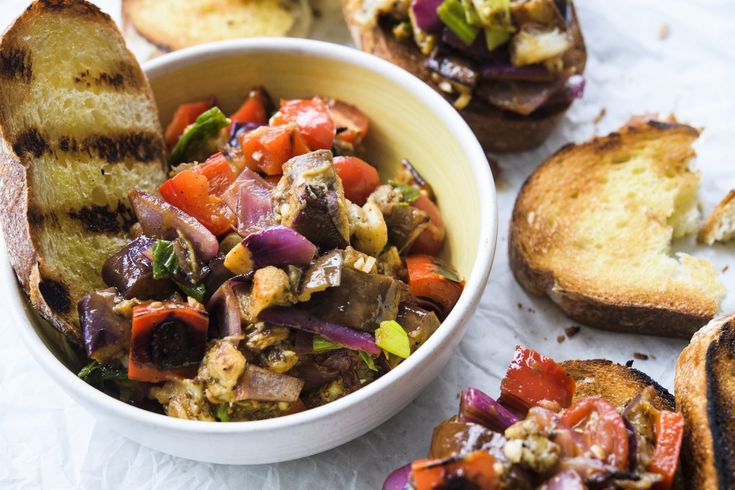
Suquet de pescadors
(fisherman’s stew with monkfish and potatoes)
While there’s not much in the way of liquid in this simple fish stew, a small bit of deeply flavored sauce — the suquet, the diminutive for suc (juice) — gives the dish its name. Suquet comes from the fishing villages of the Costa Brava, where pescadors prepared the dish either on their boat out at sea or beside it once back on shore, using the fish that wouldn’t fetch much in the market.
Bacallà a la llauna
(salt cod baked “on the tin”)
Dried and salted cod was the ideal fish to store in pre-freezer days. But once desalted through soaking and then cooked, it has a flavor superior to the fresh stuff. There are countless recipes for this key Catalan staple, and bacallà a la llauna is one of the best. Originating in Barcelona restaurants during the 18th century, it is prepared in a llauna (a rectangular baking tin) with olive oil, paprika, and plenty of sliced garlic.
Mongetes amb botifarra at El Quim.
Mongetes amb botifarra
(white beans with grilled pork sausages)
Many Catalans consider this pairing of white beans and fat, fresh sausages their national dish. It is pure country fare that has been widely embraced in Barcelona as well. Note the order in the dish’s name: It’s the tender beans here that are key. Be sure to generously dollop with allioli.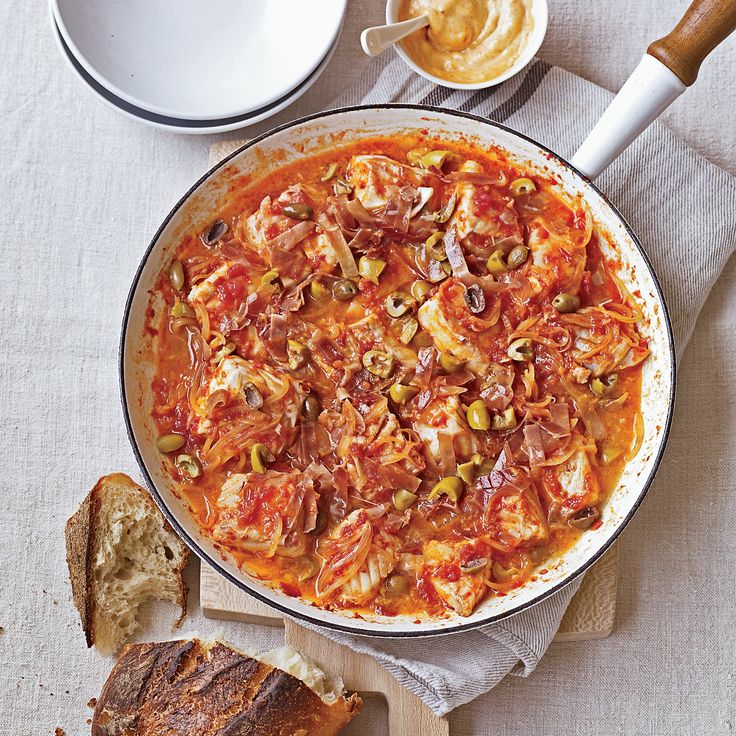
Mandonguilles amb sípia i pèsols
(meatballs with cuttlefish and peas)
One aspect of the traditional Catalan kitchen is combining the mar i muntanya (sea and mountains) in the same pot. The combinations are often original, even unexpected. One enduring favorite is this dish of stewed meatballs (rolled from equal amounts of pork and beef) with cuttlefish and fresh peas. Be sure to use plenty of bread to mop up the rich, picada-thickened sauce.
Cargols a la llauna
(snails grilled “on the tin”)
Whether cooked in a spicy tomato sauce or stewed with rabbit, snails hold an important place in Catalan cuisine. There are more than two dozen traditional Catalan recipes for cargols — more than twice that for chicken. Try them grilled a la llauna. Placed on the baking sheet with their openings facing upward, the snails are drizzled with olive oil, seasoned with salt and pepper, given a pinch of finely chopped garlic and parsley, and cooked in their own juices.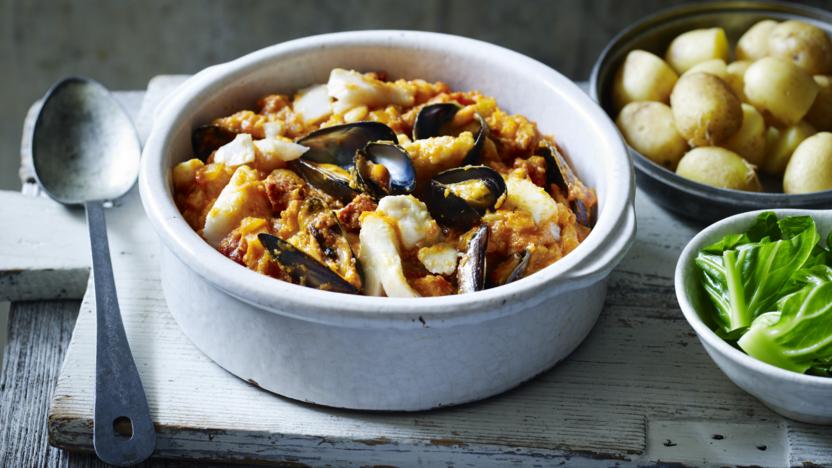
Mel i mató
(honey with fresh cheese)
Fresh cheese smothered with honey and garnished with nuts couldn’t make for a simpler dessert. Made in Catalunya since medieval times from cow or goat’s milk (or a mixture for the two), mató is a soft and slightly textured cheese, with a great milky freshness. Sugar can be sprinkled on top but honey is the classic sweetener.
Crema catalana at El Quim.
Crema catalana
(Catalan burnt cream)
There may be no more perfect way to end a meal than breaking through a thin crust of burnt sugar with a spoon to a creamy custard scented with lemon peels and cinnamon. Crema catalana is similar to creme brulee; the Catalan version is thickened with milk, egg yolks, and starch rather than whole eggs and cream. Local legend credits convent nuns who prepared a flan for a visiting bishop. The flan failed, and the nuns added some burnt sugar to the top of the liquidy mess to salvage the dessert. When the bishop took a bite, he shouted, “Crema!”— Catalan for “It’s burning hot!” as well as for “cream.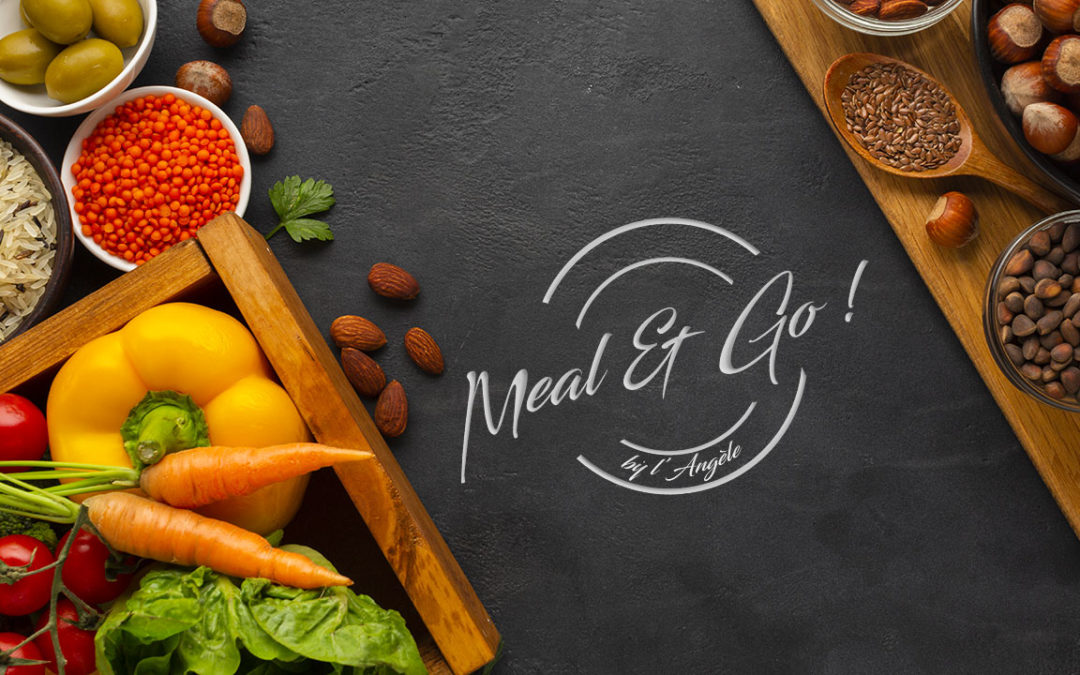
Jeff Koehler, winner of a James Beard Award and two IACP cookbook awards, has lived in Barcelona since 1996. He is the author of seven books, including La Paella and Spain: Recipes and Traditions. Gerard Moral is a Barcelona born and based photographer specializing in portrait, travel, and lifestyle photography.
Traditional FOOD in Barcelona: 17 typical Catalan dishes
When visiting Barcelona, one of the highlights is the food. Not only Catalonia is a beautiful region but also boasts some of the best gourmet delicacies in Spain. Typical food in Barcelona is quite different from what you might have in mind if you have tried traditional dishes in other parts of the country. If you want to, not only see the sites but also try the local dishes, I have prepared a comprehensive list of the most traditional food in Barcelona.
Fish and seafood typical Catalan dishes
Esqueixada de bacallà
The main ingredient in this dish is cod (bacallà), a widely eaten fish here in Catalonia. In this case, the salted cod has been shredded to get the proper consistency. Add to it some chopped tomatoes, red peppers and onions plus black olives and a healthy drop of olive oil and, voilà, you have an amazing summer dish. A very refreshing gluten-free dish for those hot summer days in Barcelona.
Esqueixada de bacallà
Arròs negre
A black dish? Really? Using the squid’s ink to flavour a recipe is very common on the coast of Spain. In the North of Catalonia, we have this black rice (literally) that is cooked in the same pot as the paella, a flat wide pan. Of course, don’t expect only the flavour of the ink but also the colour! As you can guess, squid is the main ingredient here, together with the rice. A good arròs negre is always served with allioli, a homemade garlic mayonnaise.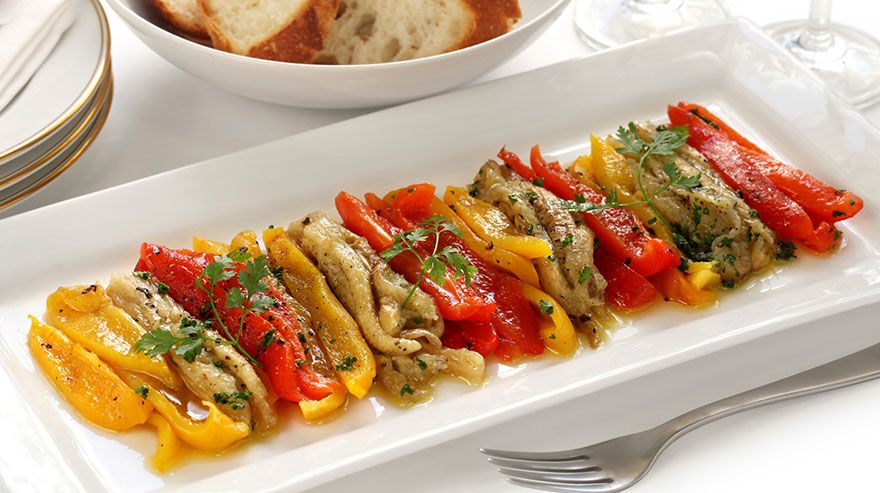
Arròs negre in Barcelona
Fideuà
Although originally from a town in the Valencia region, it is very widely eaten in the Catalan coast too. Very similar to a seafood paella but made with noodles instead of rice. Monkfish, squid and prawns are usually added before cooking everything in a fish and shellfish stock. The presentation of a fideuà is always spectacular as it comes out on the dish it is cooked, the flat paella dish. Like with black rice, allioli is a great accompaniment.
Traditional fideuà
Bacallà amb samfaina
Salted cod is very widely eaten in Catalonia. The fish need to be desalted for up to 3 days before you can start cooking it although, nowadays, it can be bought already desalted in speciality shops. The accompaniment is a sauce made with vegetables, onion, garlic and tomatoes very very similar to the Castilian pisto or the French ratatouille. If you like tomato sauce, vegetables and fish, try this original combination and don’t forget the bread to soak it all up.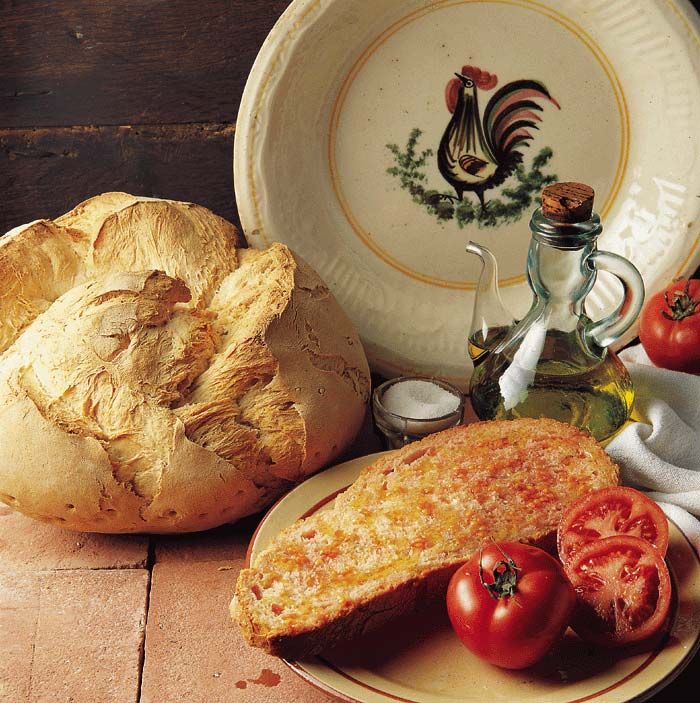
Bacallà amb samfaina
Mandonguilles amb sípia
What a great Catalan invention. Meatballs cooked with cuttlefish in a rich gravy sauce. Really tasty and original. In fact, this combination of meat and seafood is very common and we call it mar i muntanya, literally, sea and mountain. The pollastre amb llagosta, chicken and lobster (the version from Mas de Torrent is the main image in this article) is definitely the king of this Catalan version of the “surf & turf”.
Mandonguilles amb sípia
Traditional food in Barcelona for meat lovers
Canelons
Adopted by the people here, cannelloni is considered a typical Barcelona dish. It tends to have stewed meat inside the tubes rather than the Italian minced meat. That is why it is traditional to eat them on December 26th using the leftovers from Christmas dinner. The cannelloni is always also topped with a béchamel sauce (very little, if any, tomato sauce is used).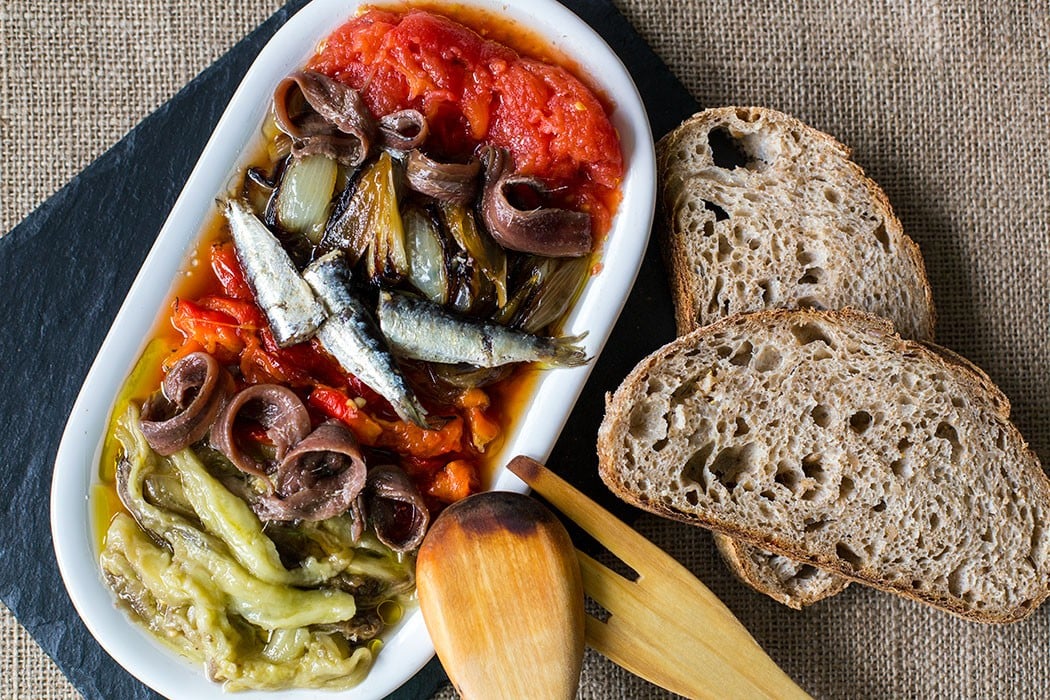
Barcelona’s Canelons
Escudella i Carn d’Olla / Sopa de Galets
Once the winter arrives, everyone fancies a nice warm dish. That is what escudella i carn de’olla exactly is. Not one but two dishes combined that are so intimately related. First, different types of meat are cooked forming a broth. This broth is served as the first course in the form of a soup that includes pasta or noodles. For mains, all the different meats are presented in an oval tray. On Christmas Day there is a variation of this traditional Catalan dish when the soup transforms into sopa de galets, with the big snail-shaped pasta shells.
Sopa de Galets, a Christmas dish
Faves a la Catalana
Made with mainly fava beans, stock and a small bit of botifarra negra, a Catalan blood pudding. Both a filling and hearty dish, this bomb is usually cooked in an earthenware dish.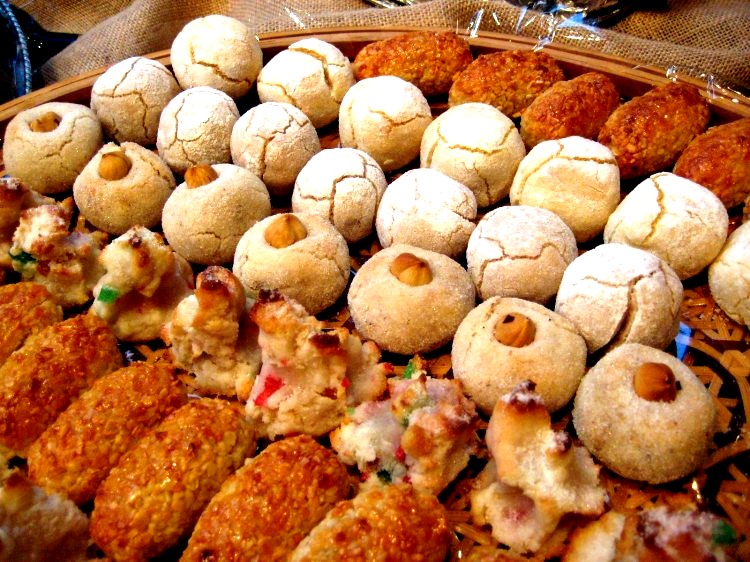
Faves a la Catalana
Botifarra amb mongetes
This is a simple but effective dish. Like bangers and mash to the English but, instead of the potatoes, we have haricot beans served with the sausage. Traditional food in Barcelona city but even more enjoyable after a long hike in the countryside.
Botifarra amb mongetes
Fricandó
These are slices of veal cut and cooked in a rich sauce with seasonal mushrooms. Forget your Sunday roast with gravy. This is way nicer and a great way for meat lovers to taste traditional food in Barcelona.
Traditional Fricandó
Ànec amb peres
Another great example of the way Catalans mix sweet and savoury beautifully. Pieces of duck are cooked slowly and served with pears. This is a very special dish reserved for festive occasions.
Ànec amb peres
Cargols a la llauna
One of the delicacies that this area gives us is snails.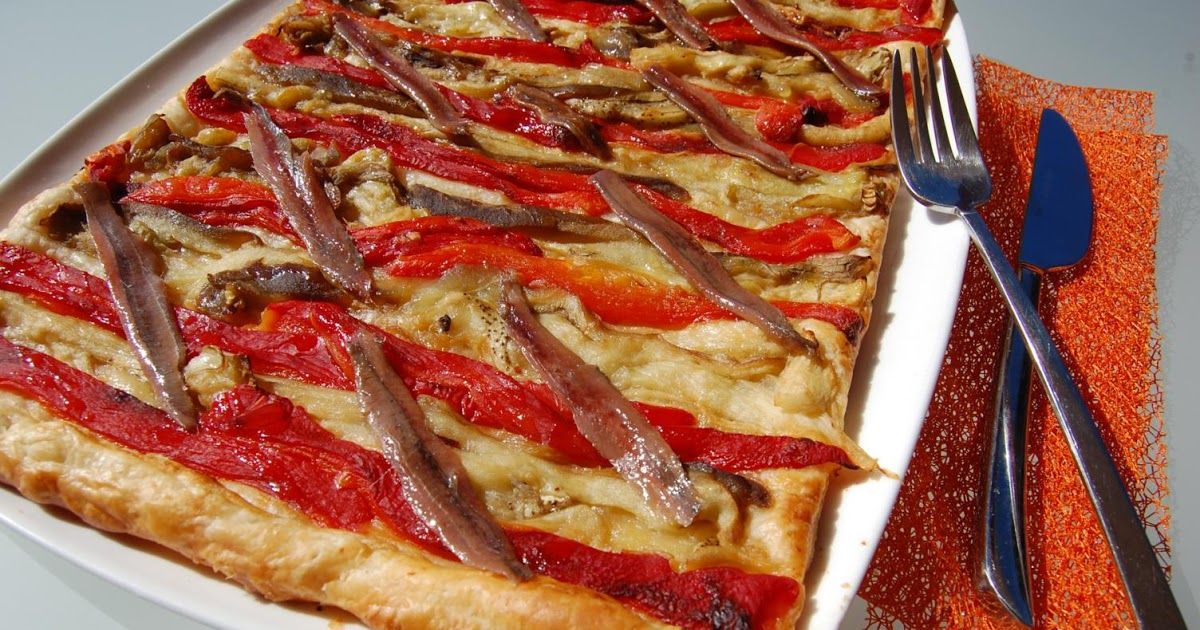
Cargols a la llauna
Cold cured meats
Spain is, of course, famous for its jamón (cured ham) but the meats below are particular to this region:
- Botifarra negra: pork blood sausage.
- Botifarra blanca: white pork sausage.
- Botifarra d’ou: white pork sausage with egg.
- Fuet: a long thin sausage of dried cured pork meat wrapped in the gut. It resembles a salami.
Fuet (dried cured pork)
Vegetarian traditional Catalan food to die for
Pa amb tomàquet
It consists of toasted Catalan country bread scraped with garlic (optional) and lightly coated with the flesh of fresh tomatoes.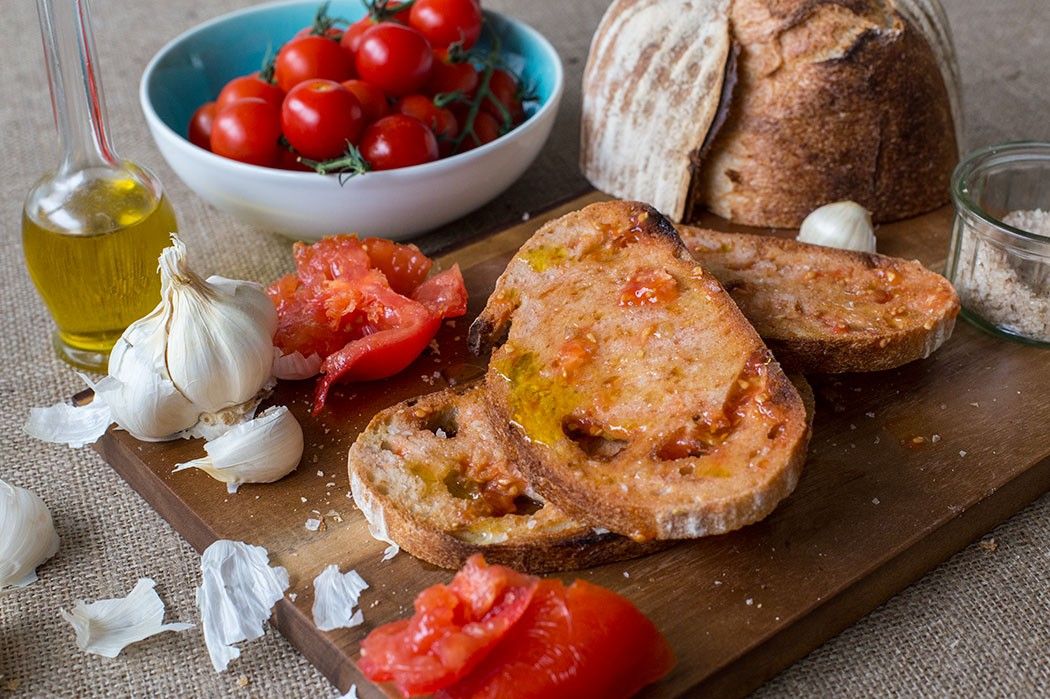
Traditional pa amb tomàquet
Calçots
A type of long-stemmed green onions grown in Catalonia which is barbecued on an open fire. Charred outer leaves make them very messy to eat so a bib and gloves are sometimes provided. Did you say a bib? Yes, a baby bib! The soft inside is always dipped into a garlic, tomato and almond sauce. They are seasonal from December to March and it is one of the culinary social highlights if you visit at this time of the year. The best place to appreciate the ceremony of calçots is out in the countryside but plenty of Barcelona restaurants have them on the menu during the season.
Calçots cooked on an open fire
Escalivada
A vegetarian delight: Smokey grilled veg (red peppers and eggplant) served with olive oil as a hot or cold dish.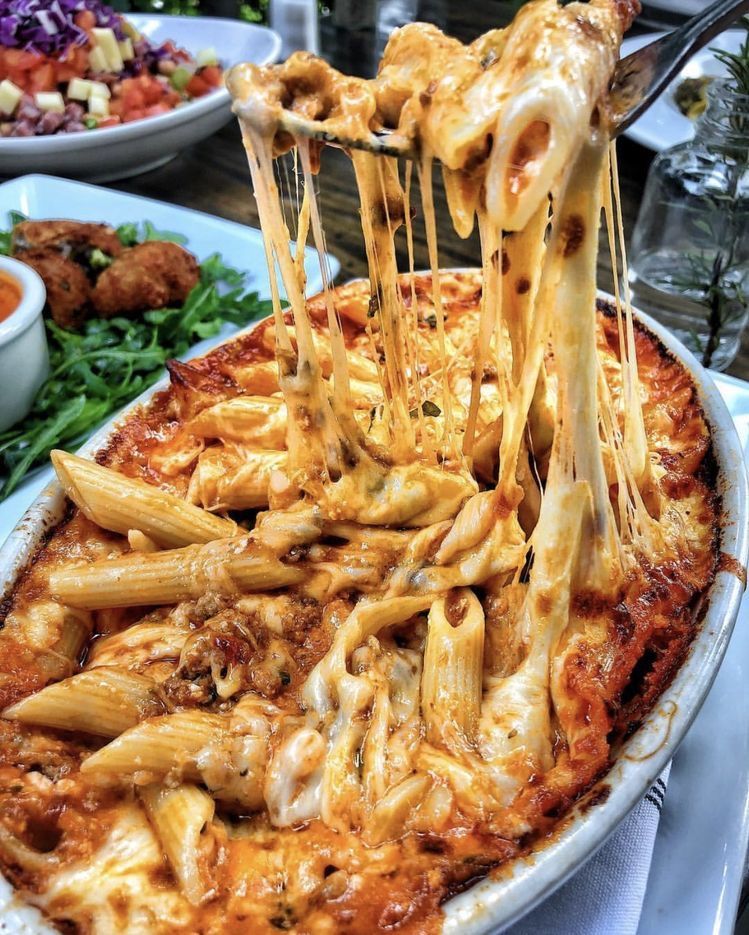
Escalivada of red peppers and eggplant
Espinacs amb panses i pinyons
This is a very simple but fab dish that has been consumed in Catalonia since medieval times. Fresh green spinach are sauteed in olive oil together with raisins and pine nuts. Sometimes the spinach has been steamed beforehand but I definitely prefer the first version.
Espinacs amb panses i pinyons
… and food tours to soak it all up
When it comes to food tours, the offer in Barcelona is huge. You probably wonder: “with so many options, which food tour do I choose?”. Our advice is to always go with a real local company.
Nowadays there are many multi-city operators that offer their food tours in different parts of Spain or even Europe, sometimes disguised as “supporting local businesses”. Great marketing strategy.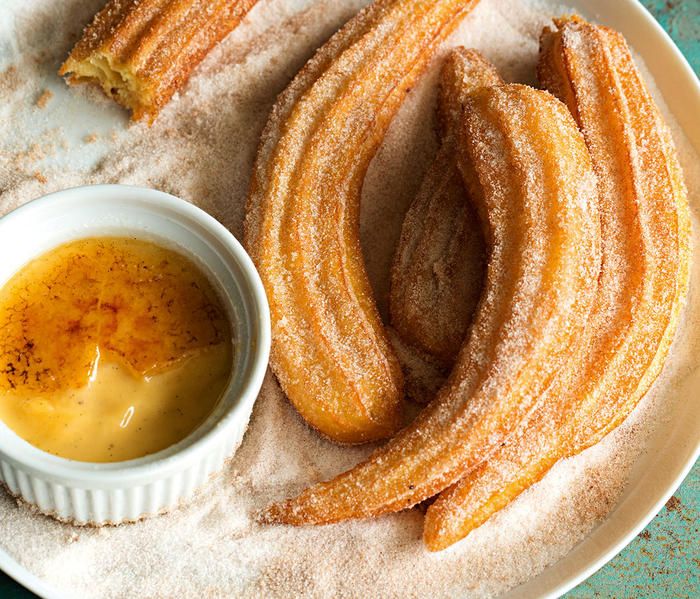
Most importantly, only a true Barcelona company can show you the soul of the city’s food that others can’t compete with.
If looking for a food tour here, always ask yourself this question: Do they offer tours in other cities? If the answer is yes, think twice about joining them and choose a real Barcelona company instead.
Our recommendation is to join Lorea and Michael from The Barcelona Taste at one of their fabulous food and tapas tours in Barcelona. What makes this company stand out in Barcelona is that their food tours are limited to 6 people maximum. While others take up to 12 people, which is too large for a nice group to interact with the guide and have a nice conversation, these guys pride themselves in keeping it as small and personal as you can get.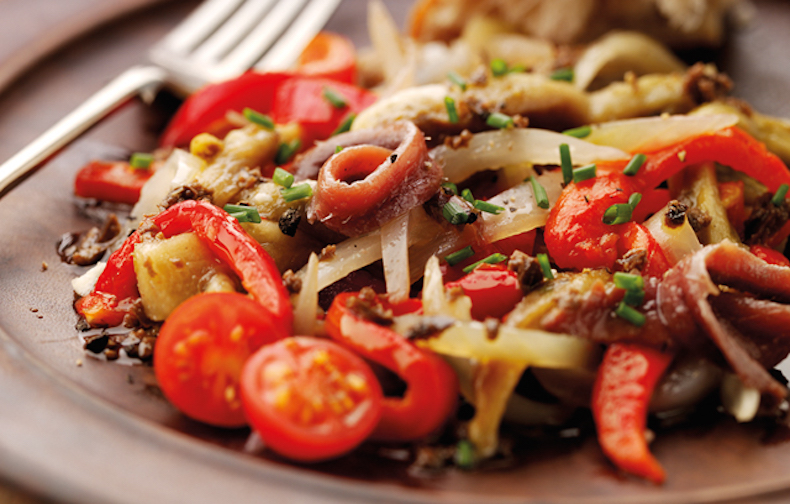
The Barcelona Taste is the first company that offered this type of food tours in the city and is still the best. Their philosophy is to awe their clients with the best food at the best local restaurants in town. They have been recommended by Rick Steves, The Guardian or Time Out. And yes, they are only in Barcelona as that is the city of their expertise. Bon profit!
Have fun on a Tapas Tour in Barcelona
I hope you will have fun giving some of these foods a whirl. But a meal in Barcelona is not complete without something sweet so why not check out our post about Catalan desserts? Looking to learn about the city before engulfing all this fantastic food? Check out our award-winning Barcelona Free Walking Tours and Barcelona Private Tours. A great way to make the most of your Barcelona trip! Finally, if you are here for a few days, you can take a look at our very complete article with things to do in Barcelona.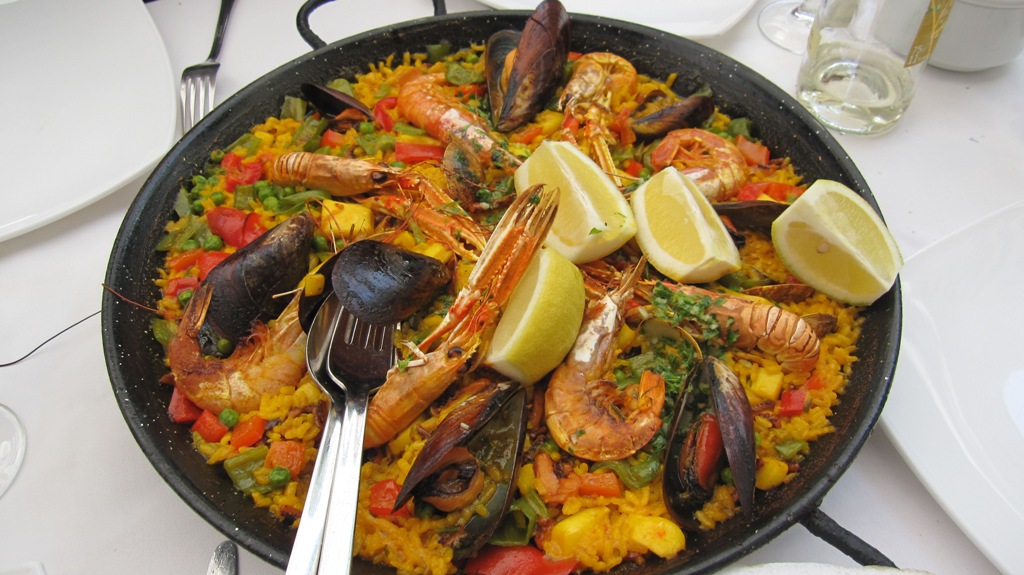
Spain is full of wonderful gastronomic experiences. If you are travelling outside Barcelona, you can check out our friends’ posts for traditional food of Madrid and typical dishes in Malaga.
Post originally published on July 28th 2014. Updated on January 2nd 2022
Photographs by Javier Lastras, mpellegr, ihq, Jorge Franganillo, demoslavueltaaldia, Niu de Sol, Emi Yañez, Lablascovegmenu, Kent Wang, Mover el Bigote, foodandfoot, benremenat, allijulivert, Jacob Sunol, Gustavo Maximo, mumumío and Diari Ara
Catalan Cuisine – SECRETS OF BARCELONA
Have you been to Barcelona, ate paella and tapas ? You might as well go to a pizzeria or a sushi bar. Paella is from Valencia and tapas is eaten all over Spain. Catalan cuisine is completely different dishes.*
In some ways it intersects with the gastronomic traditions of other countries and regions of the Mediterranean (Spain, France, Italy, Portugal), and some of its recipes are absolutely unique.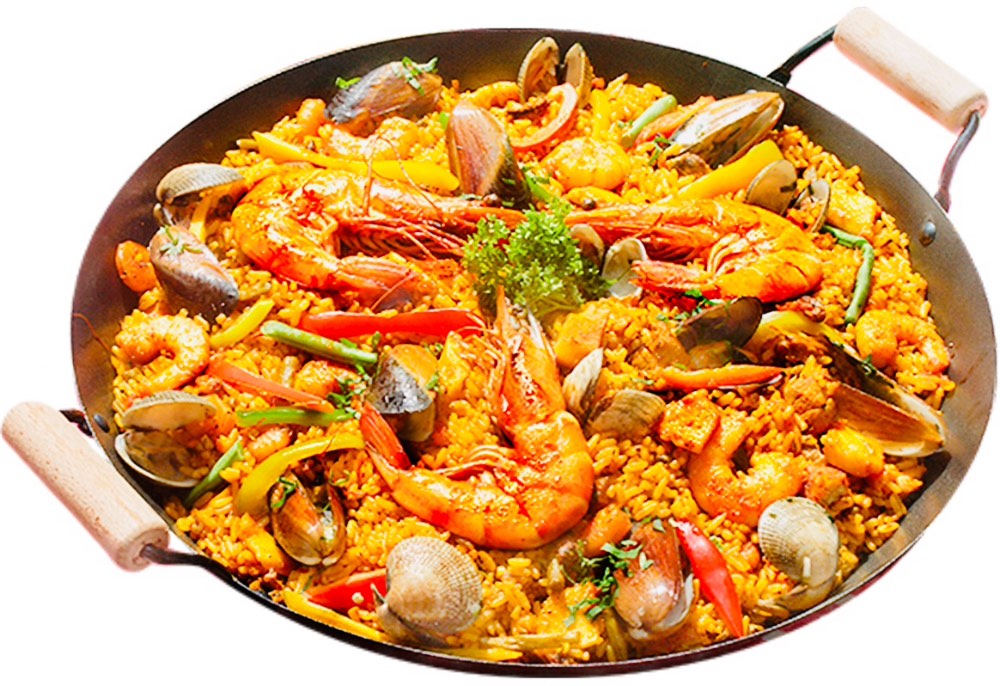
One of the distinguishing features of Catalan gastronomy is precisely the diversity and the desire for a balance of different ingredients: meat and poultry, fish and seafood, fresh and cooked vegetables, mushrooms, snails, etc.
Escudella
The Catalans eat absolutely everything, but at the same time they like very much that the food is as fresh as possible and, if possible, local – prepared from what is typical for this particular area. Therefore, the menu in establishments is very dependent on where you are: do not expect such an abundance of fish and seafood in a mountainous Pyrenean village that coastal resorts have taught you.
In each region of Catalonia you will certainly find dishes typical of these places, which will not be so easy to find in other parts of the country.
Below we have selected 15 traditional dishes of Catalan cuisine , which, in our opinion, best reflect all its richness and diversity.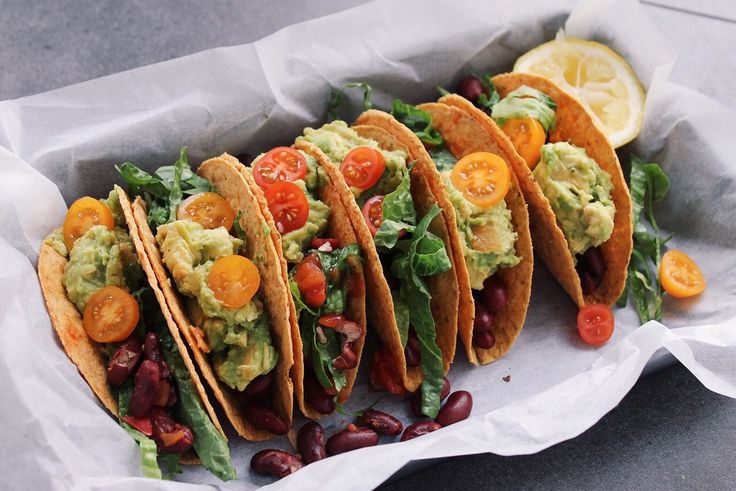
Bread with tomato
1. Bread with tomato (Pa amb tomàquet)
A universally recognized symbol of Catalan gastronomy, known to everyone who has ever visited Barcelona and the surroundings . An extremely simple snack, which, nevertheless, you instantly get used to, and then miss it for a long time, being outside the borders of Catalonia.
Ingredients: Bread (usually lightly grilled), soft tomato, olive oil, salt, and, in the countryside, garlic.
2. Escudella (L’escudella amb carn d’olla)
Thick winter soup, one of the symbols of the Catalan Christmas . The rich broth contains several types of meat and poultry, black pudding botifarra negra , vegetables and a special kind of pasta. Christmas escudella is eaten in two doses – for the first broth with pasta, and for the second – meat and vegetables that were cooked in it.
3.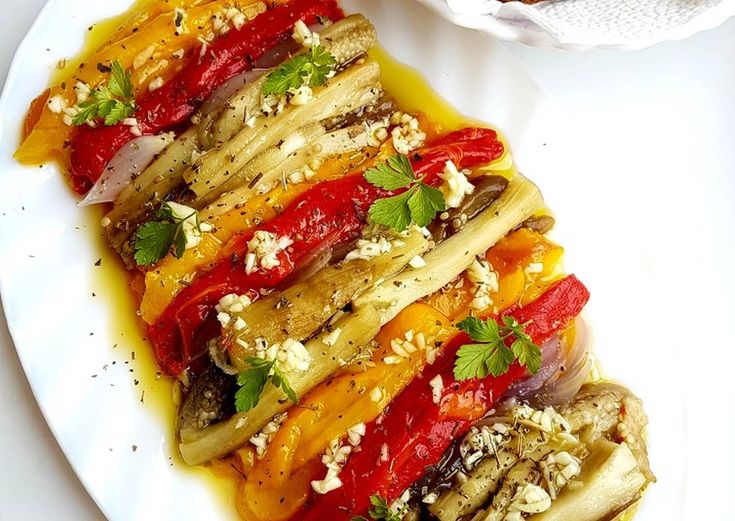
Another rather simple but iconic dish for the Catalans is pork sausage, which is usually grilled over coals. The composition of the classic butifarra is obscenely simple – meat, salt and a natural casing. True, sometimes Catalan butchers like to bother with the preparation of butifarra, and then anything goes into business – a wide variety of vegetables (and sometimes fruits), mushrooms, cheese, beer, cava …
A subspecies of butifarra especially beloved by the editors – botifarra negra , or black pudding.
And in the vicinity of Girona they sometimes make sweet butifarra – botifarra dolça .
Escalivada
4. Escalivada
The main vegetable dish of Catalonia. Whole eggplants, sweet peppers, tomatoes and onions are baked on the grill, from which they are then peeled, cut and served as a side dish for meat or as an independent snack.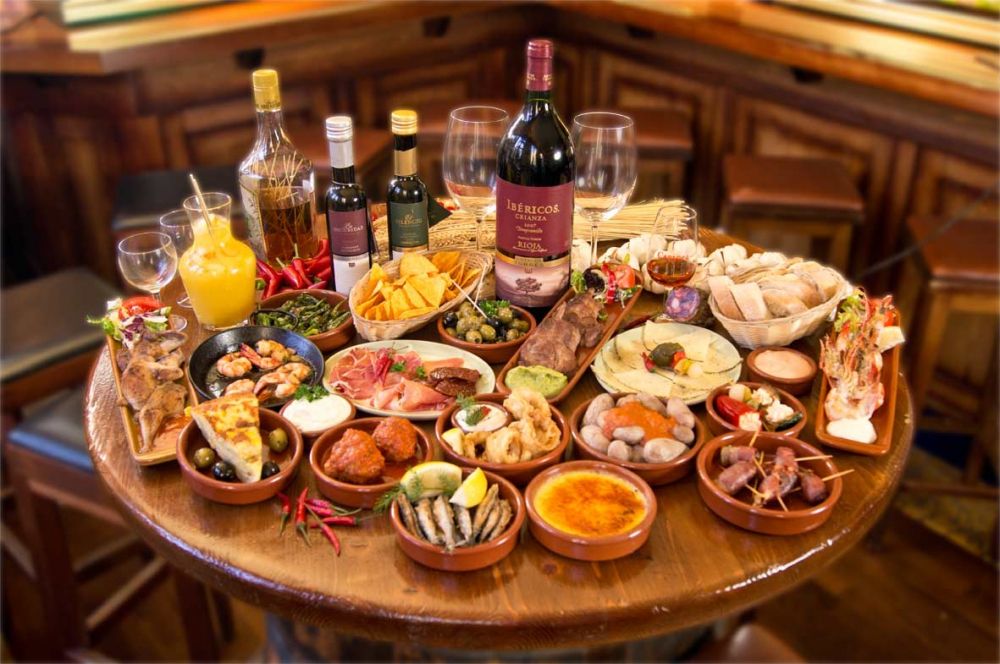
In the second case, vegetables can be supplemented with salted anchovies, herring or blood butifarra.
5. Canelons
Canelons, or canelloni, is an immigrant dish that was brought to Barcelona by the Italians in the mid-19th century and first became a favorite hot snack of the Catalan bourgeoisie, and then entrenched as a traditional food on the second day of Christmas .
Rectangular sheets of pasta rolled into a tube and stuffed with minced meat (usually baked veal or pork, but may also be chicken)
Fideua
6. Fideuà
Everyone knows what seafood paella is, I guess? So, fideua is actually the same, only instead of rice, small noodles (vermicelli) are used, which are baked with shrimp, mussels and pieces of cuttlefish.
Another difference from paella is that fideua is always served with allioli sauce.
7. Baked snails (Cargols a la llauna)
Snails are very popular in the Catalan province Lleida .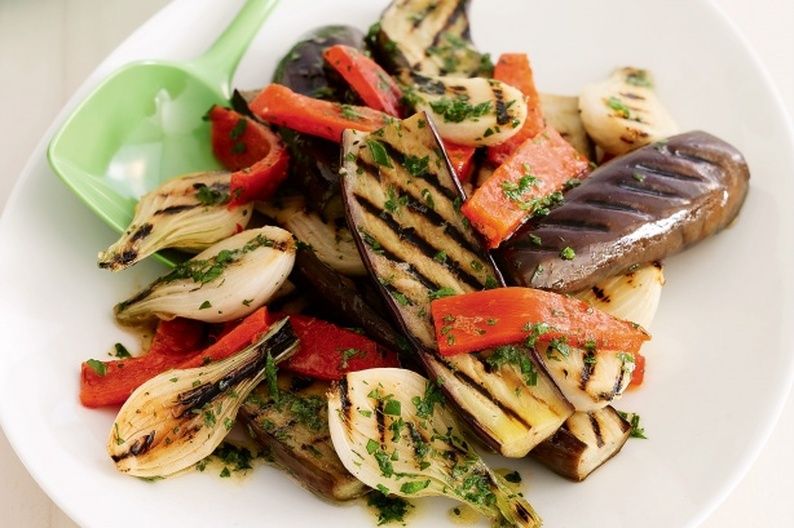
Snails are eaten a la llauna also with garlic-olive allioli sauce (allioli) .
8. Baked cod (Bacallà a la llauna)
In addition to snails, soaked salted cod, another of the most typical ingredients of the Catalan national cuisine, can be baked on the llauna tin tray. Salting cod in the old days made it possible to store it for a long time and transport it over long distances, therefore often in the regions of Catalonia remote from the coast, it is baked cod that is the only fish dish on the menu.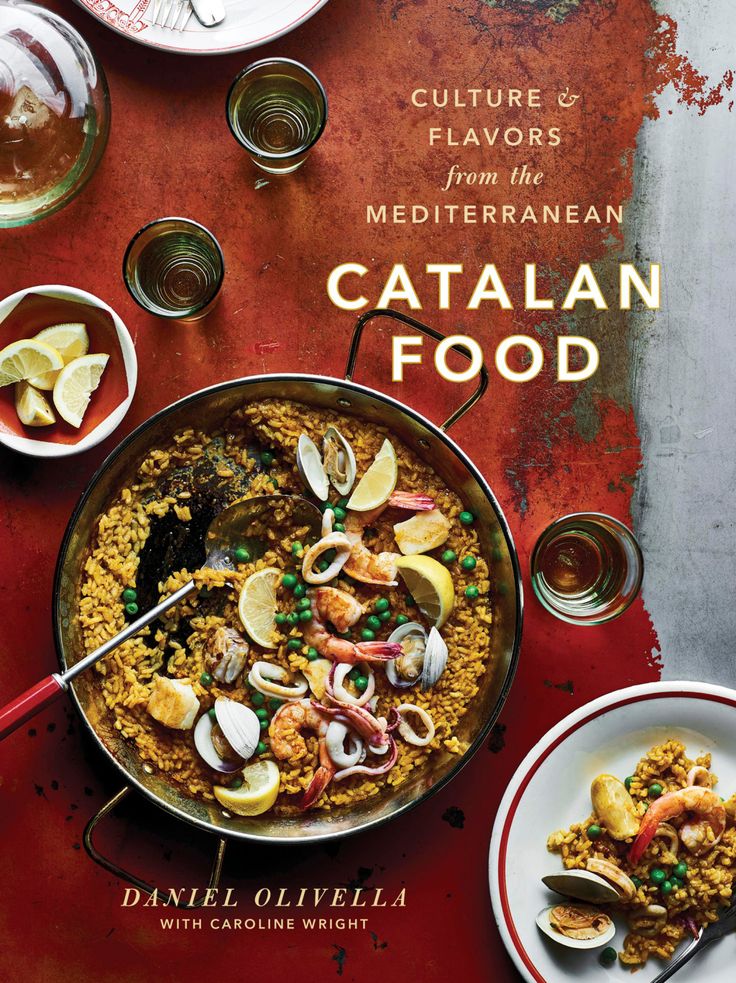
Suquet in Cadaqués
9. Suquet
A real culinary masterpiece for lovers of fish and seafood. Suquet is the main traditional delicacy of the coast Costa Brava . The essence of this dish is that several types of fish and seafood are baked in fish broth with the addition of potatoes and vegetables.
10. Calçot onion
The main gastronomic pride of the Catalan winter, especially popular around the cities Waltz and Tarragona. This special type of onion, which grows from January to March, is roasted over charcoal, the top layers are burned off, and the tender core is eaten with a Romesco walnut and vegetable sauce. It may not look very attractive in the photo, but it tastes delicious!
11. Esqueixada
Another dish of soaked salt cod bacallà . More specifically, a cold snack. Cod is cut into cubes or strips and mixed with finely chopped vegetables – tomatoes and onions, and poured with olive oil and vinegar.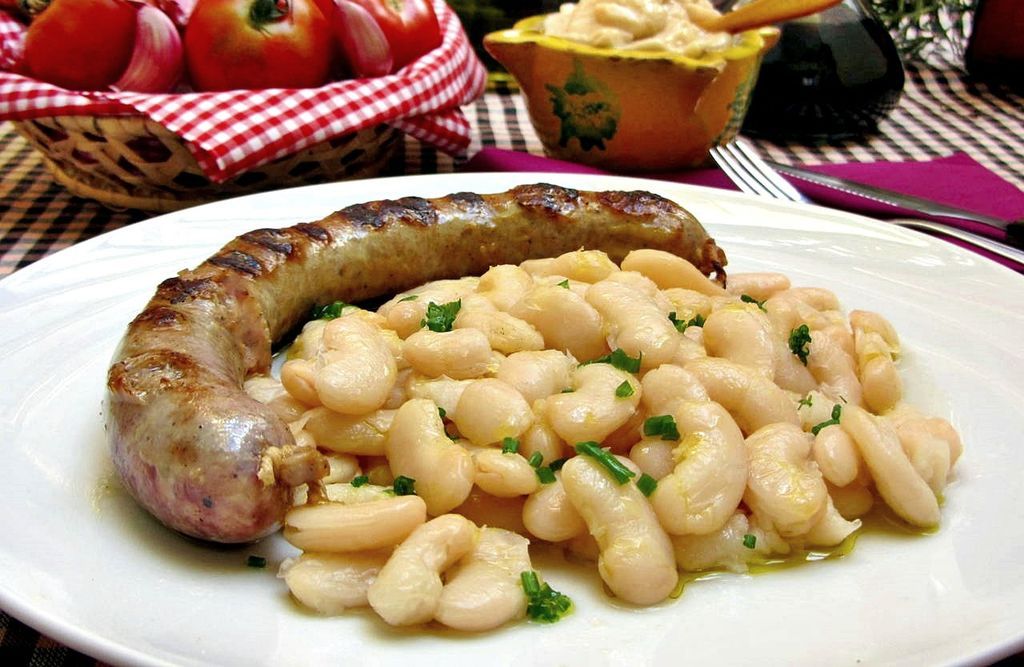
12. Arròs mar i muntanya (Arròs caldós mar i muntanya)
Mar i muntanya, which means “sea and mountain” in Catalan cuisine, is the combination of meat, vegetables and fish in one dish with seafood.
A classic example is mar y muntagna rice, which features both prawns with mussels and butifarra sausage with pork ribs.
Sea and mountain rice is best prepared in the town of Pals in the Empordà region, famous since the Middle Ages for its local rice.
13. Grilled mushrooms (Rovellons a la brasa)
The Catalans are absolutely crazy about mushrooms – both eating and picking, which is rare in Europe. But the main mushroom here is by no means white, but camelina. It is prepared in the simplest way – put on a grill or a frying pan, sprinkle with salt, add finely chopped garlic and parsley. In rainy autumn, this dish will be present in most traditional restaurants in Catalonia.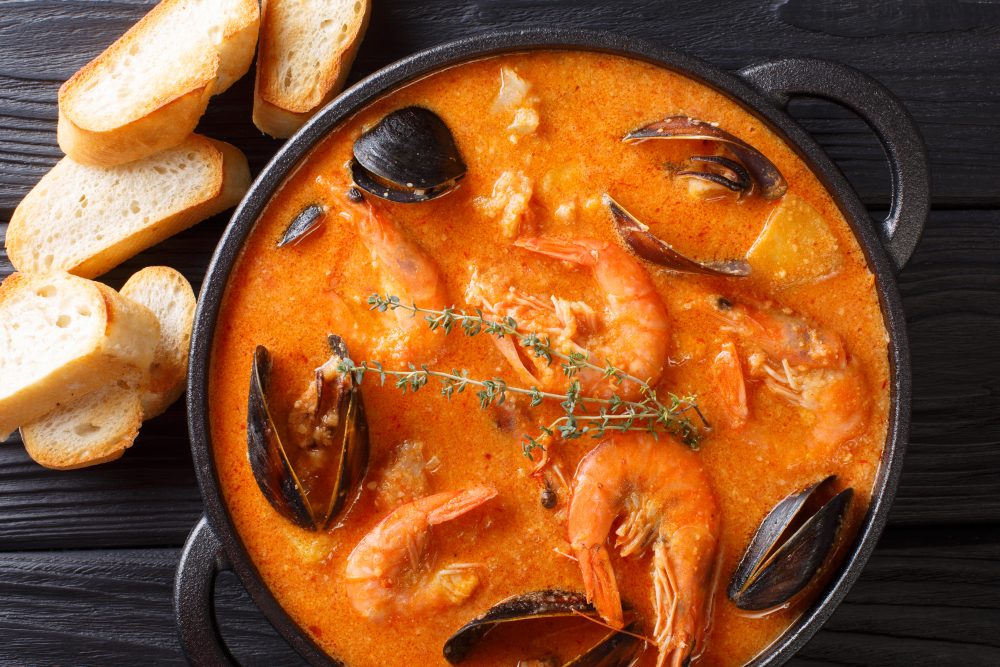
14. Catalan spinach (Espinacs a la catalana)
The most typical dish of the Catalan Middle Ages. Pan-fried spinach is served mixed with raisins, pine nuts and finely chopped garlic. The dish is a storehouse of vitamins and minerals.
15. Chateau (Xató)
Well, let’s finish the list with a salad. Chateau is a salad characteristic of the coastal towns between Barcelona and Tarragona – Sitges, Vilanova i la Geltru, etc.
It is named after the sauce of the same name xato , which includes almonds and hazelnuts, olive oil, niora, garlic and bread. The sauce is seasoned with lettuce chicory leaves, salted cod already familiar to us, and salted anchovies, olives and tuna canned in oil are also added.
*In fact, paella is also a traditional dish of Catalonia. She is very loved and knows how to cook in the South Catalan region of Delta de l’Ebre (Ebro River Valley). It’s just that the editors really don’t want to be considered the main symbol of Catalan cuisine .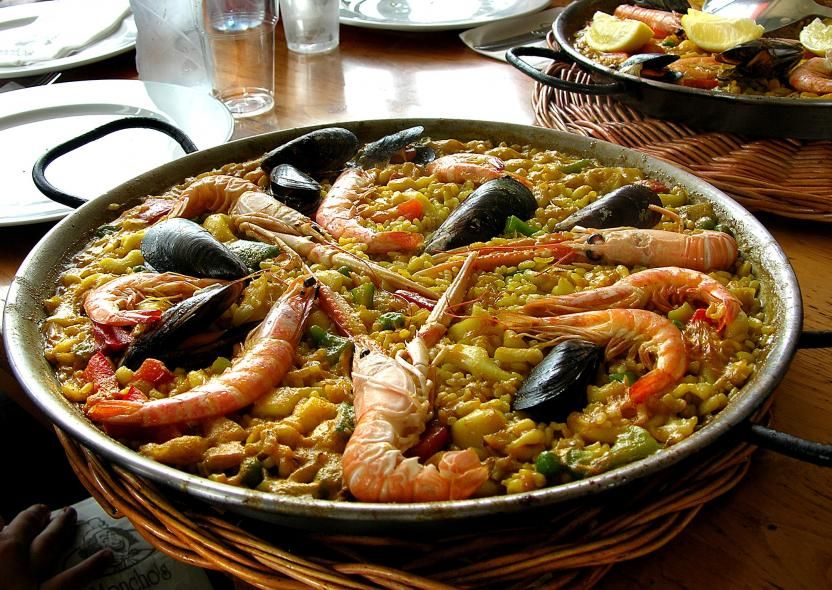
Catalan breakfast: bread and tomato, butifarra, glass of cava
© Barcelona Secrets 2018
Guide to traditional authentic Catalan cuisine
Page Content
| Tomatoes |
I confess that I am a food lover, and the gastronomic delights of Barcelona played an important role in my decision to move to this city. Before moving, I thought I knew everything about Catalan cuisine. I was burning with impatience, to try cheeses, meat and seafood as soon as possible. Like Catalonia itself, its cuisine is much deeper than meets the eye – forget paella and chorizo, think butifarra and fideua!
Barcelona and its surroundings are world renowned for their cuisine and culture. In recent years, a new generation of experimental chefs such as Ferran Adria (founder of El Bulli) has begun to bring Barcelona to the attention of gourmets from all over the world.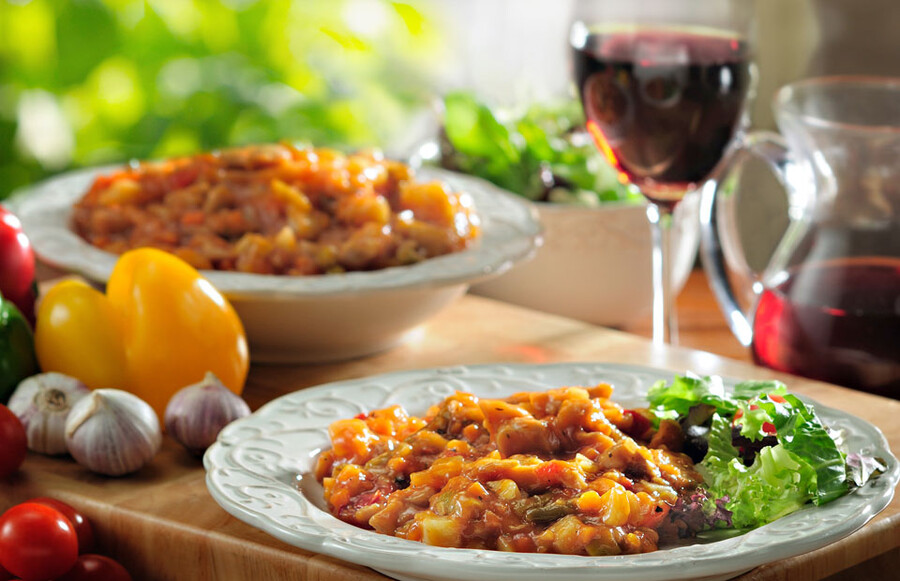
| Mushrooms |
Located on the Mediterranean coast, this region has access to a wide range of products, which allows you to create very original dishes. Close proximity to the sea means wonderful seafood dishes, and vegetables such as tomatoes, red peppers, eggplants, artichokes and mushrooms have never been lacking. At the same time, it is easy to forget that Catalonia is not only the sea, but mountains and fields where sheep and pigs graze. Hence the interest of the Catalans in “May Y Mantagna” (“Sea and Mountains” – a dish of seafood and meat!) – this dish combines fish and meat on one plate.
| Typical Catalan salsa |
There are dishes in Barcelona that you can’t miss, like Pan Con Tomate and Crema Catalana. But there will be dishes that will not be easy to find. In this article, I will talk about dishes that are considered typical Catalan.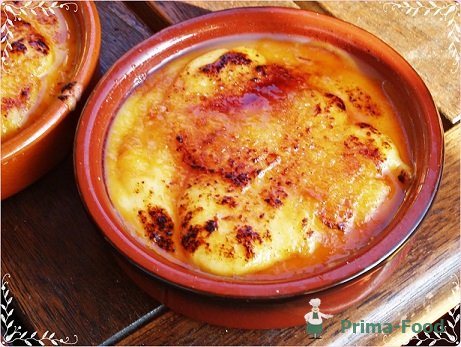
Bon appetit, or, as they say in Catalonia, “Bon Profit”!
Typical Catalan dishes
The names of all dishes are in Catalan, and the name in Castilian (Spanish) is given in brackets.
Vegetarian meals
Pa Amb Tomaquet (Pan Con Tomate): Bread rubbed with tomato, drizzled with oil and sprinkled with salt. Main Catalan snack.
| Calçots |
Calçots: This is a young leek that only occurs in spring when the traditional festivities called “Calçotadas” are held. Vegetables are usually fried and served with romesco sauce (see below).
Escalivada: This is a salad of fried vegetables with butter (usually eggplant, red peppers, onions and tomatoes) that have been de-seeded and skinned.
| Typical selection of meat products |
Meat dishes
Butifarra: Raw seasoned sausage reminiscent of homemade sausage.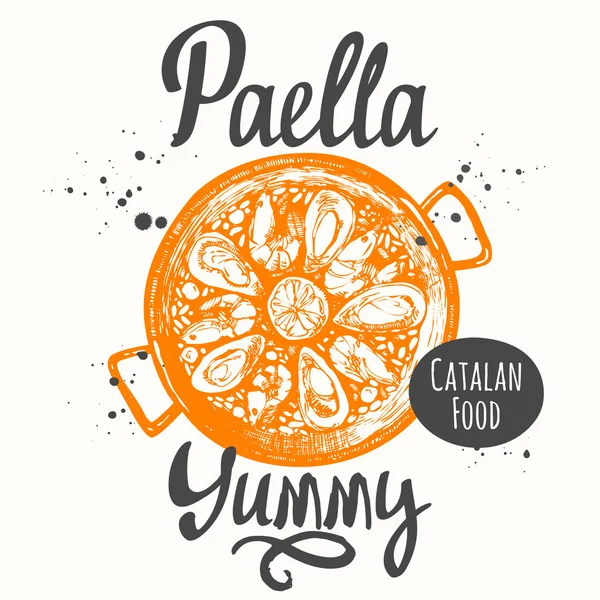
Escudella: Catalan stew with meat, beans, potatoes and sometimes pasta. This dish is served in three doses, first comes the broth, then the meat, and then the vegetables.
Xai Rostit Amb 12 Cabeçes d’All: Literally translated as “Lamb roasted with 12 heads of garlic” – the name says it all!
Embutidos: This is a common name for a plate of smoked meat: fuet (pork) and jamon from the Vic region.
Fish dishes
| Bacalao |
Esqueixada: Salad with peppers, tomatoes, onions, red wine vinegar and chopped bacalao. Bacalao is salted cod, very typical of the area. First, it is salted, and soaked in water before serving.
Fideuas: Similar to seafood paella, but served with short noodles rather than rice.
Suquet de Peix: Seafood ragout with potatoes, garlic and tomato.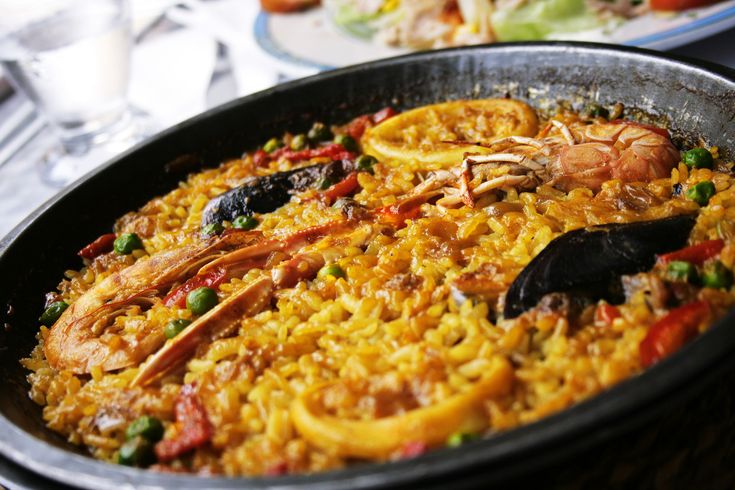
| Dried red peppers with romesco sauce |
Sauces
Romesco: Sauce of almonds, roasted garlic, olive oil and dried red peppers.
Alioli: Garlic and olive oil sauce. The ingredients are whipped for a long time until they turn into a paste.
Dessert
Crema Catalana: Similar to French creme brulee. Made with sugar, egg yolks and cinnamon, done so that it is slightly burnt on top.
Mel I Mato: Soft, not salty goat cheese with honey, sometimes with nuts.
Panellets: Small round sweets made with almonds, sugar, eggs and pine nuts. They can be sprinkled with anything, but in the traditional version, pine nuts are used.
Traditional Catalan restaurants in Barcelona
To find authentic and traditional Catalan restaurants, turn off the main streets, away from the Ramblas.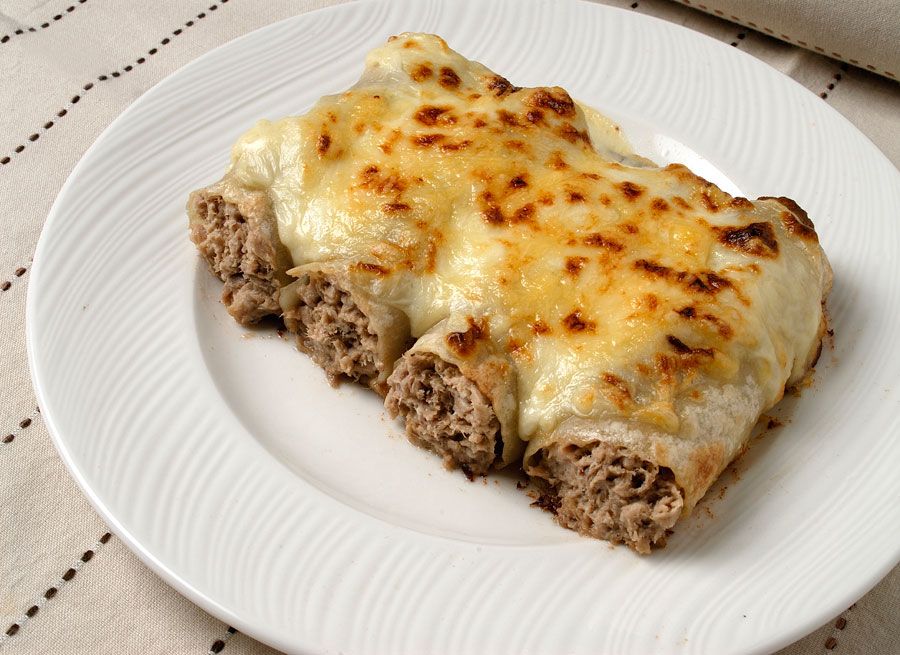
Boqueria Food Market: This world-famous market is not only famous for its products – it also has eateries that serve fresh produce in a lively environment.
Cal Pep: One of the most famous tapas bars in Barcelona. Friendly owner named Pep will recommend you the most delicious dishes.
Can Culleretes: One of the oldest restaurants in Barcelona. It is famous for suckling pigs, among other dishes.
Los Caracoles: Another of the oldest restaurants in Barcelona. On the street, near the restaurant, there is a stone grill. It is famous for snails – “caracoles”.
| Senyor Parellada |
Senyor Parellada: Overview of Senyor Parellada in Barcelona A great place if you want to sample local cuisine in a luxurious setting at reasonable prices.

